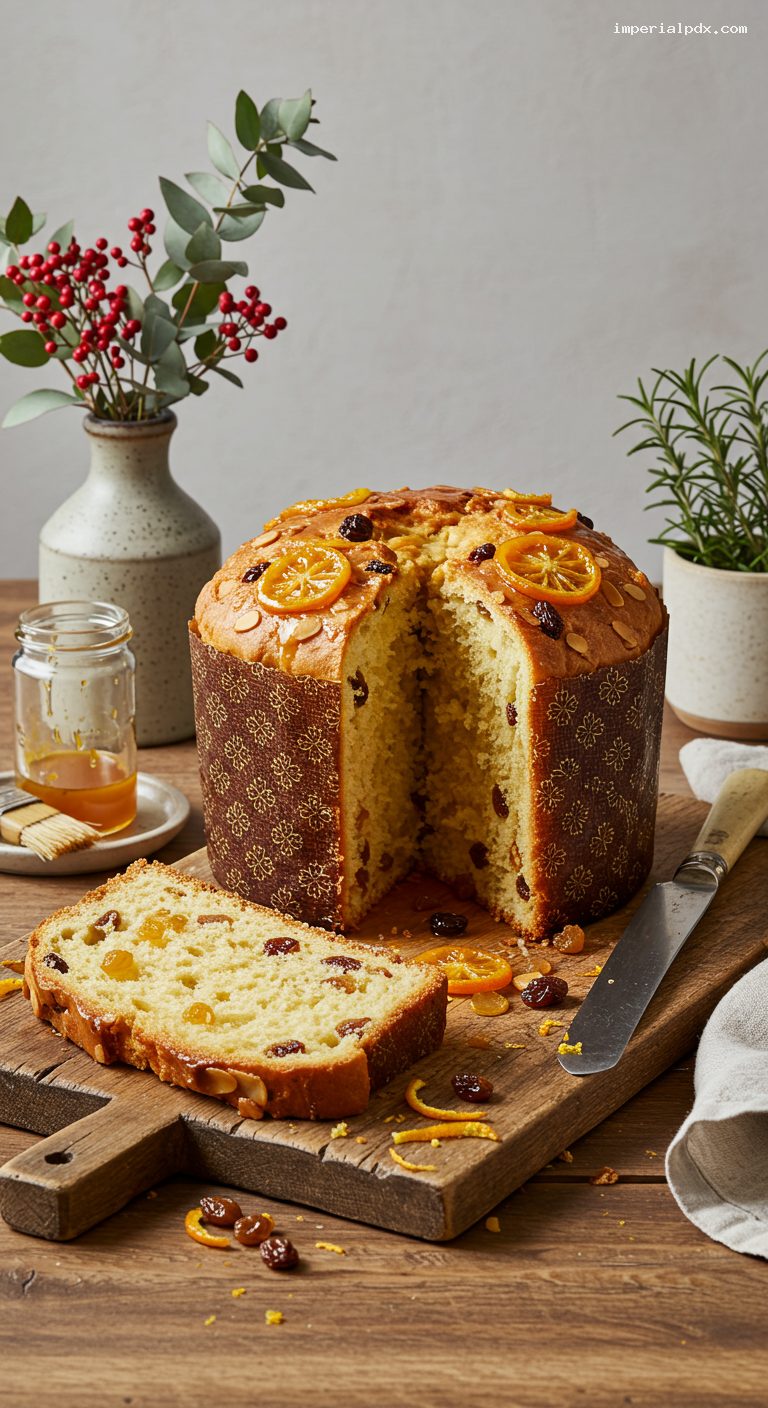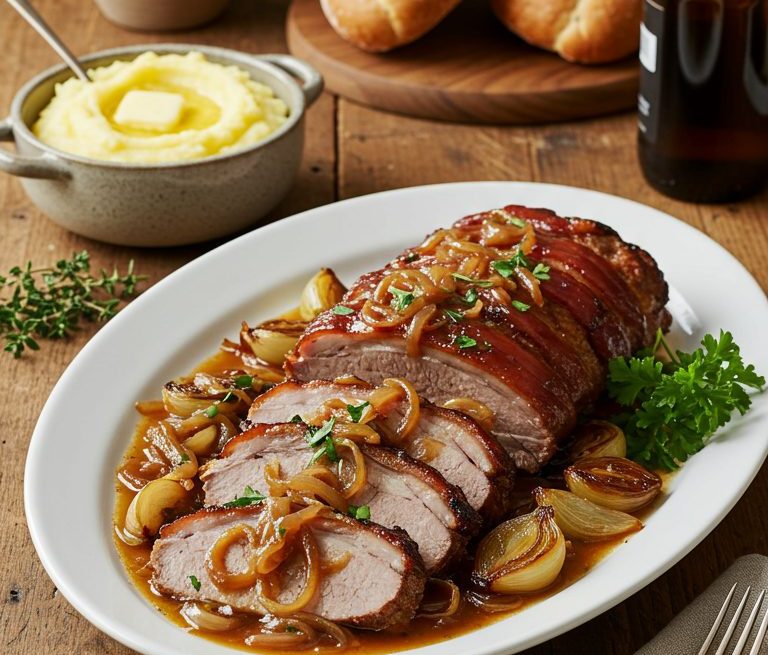Quick Recipe Version (TL;DR)
Quick Ingredients
- 500 g bread flour, divided
- 180 ml whole milk, warm (40°C/105°F), divided
- 7 g instant yeast (2 1/4 tsp)
- 120 g granulated sugar, divided
- 3 large eggs, room temp
- 120 g unsalted butter, very soft
- 30 g honey (1 1/2 tbsp)
- 2 tsp vanilla extract; zest of 1 orange and 1 lemon; 8 g fine salt
- 150 g raisins; 60 ml dark rum + 60 ml orange juice (for soaking)
- 120 g candied orange/citron; 80 g toasted almonds or walnuts, chopped
- Glaze: 80 g sugar + 80 ml water + 1 tsp vanilla
Do This
- 1. Soak raisins in warm rum and orange juice 20–30 minutes; drain and pat dry.
- 2. Make sponge: whisk 100 ml warm milk, 1 tbsp sugar, yeast, and 100 g flour; rest 20–30 minutes until foamy.
- 3. Mix dough: add remaining milk, eggs, remaining sugar, honey, vanilla, citrus zests, salt, and remaining flour. Knead, then work in soft butter until smooth and elastic (windowpane).
- 4. First rise: cover and let double, 1 1/2–2 hours at warm room temp (26–28°C/79–82°F).
- 5. Fold in fruit and nuts; shape into a tight ball. Place in a 1 kg panettone paper mold; proof until nearly at the rim, 1 1/2–2 1/2 hours.
- 6. Bake at 170°C/340°F for 35–45 minutes to 93–95°C/200–203°F internal. Brush hot loaf with warm vanilla syrup; cool fully before slicing.
Why You’ll Love This Recipe
- Classic Argentine pan dulce flavor: vanilla, honey, and bright citrus.
- Festive mix-ins: rum-kissed raisins, jewel-tone candied peel, and toasty nuts.
- Soft, shreddable crumb with a delicate syrupy sheen—beautiful and giftable.
- Step-by-step, home-cook-friendly method with exact measurements and times.
Grocery List
- Produce: 1 orange (for zest), 1 lemon (for zest)
- Dairy: Whole milk, unsalted butter, 3 large eggs
- Pantry: Bread flour, granulated sugar, honey, instant yeast, vanilla extract, fine salt, raisins, candied orange/citron, almonds or walnuts, dark rum, orange juice
Full Ingredients
Sponge (Esponja)
- 100 g bread flour
- 100 ml whole milk, warm (40°C/105°F)
- 7 g instant yeast (2 1/4 tsp)
- 12 g granulated sugar (1 tbsp)
Dough
- 400 g bread flour
- 80 ml whole milk, warm (40°C/105°F)
- 108 g granulated sugar (use the remainder of the 120 g total)
- 3 large eggs, at room temperature
- 120 g unsalted butter, very soft (but not melted)
- 30 g honey (about 1 1/2 tbsp)
- 2 tsp vanilla extract
- Zest of 1 large orange and 1 lemon (fine microplane)
- 8 g fine sea salt (1 1/4 tsp)
Fruit & Nuts
- 150 g raisins
- 60 ml dark rum (1/4 cup)
- 60 ml orange juice (1/4 cup), warmed
- 120 g candied orange and/or citron, diced
- 80 g almonds or walnuts, lightly toasted and chopped
- 1 tbsp bread flour (to toss with fruit, optional)
Syrup Glaze
- 80 g granulated sugar (about 1/3 cup)
- 80 ml water (about 1/3 cup)
- 1 tsp vanilla extract
- Optional: 1 strip orange peel or 1 tsp honey for extra gloss
Equipment
- 1 panettone paper mold (1 kg, about 18–20 cm / 7–8 in diameter) or two 500 g molds
- Stand mixer with dough hook (recommended) or strong arms for hand kneading
- Digital scale and thermometer (for accuracy)
- Skewers and a large pot/box for upside-down cooling (optional but helpful)

Step-by-Step Instructions
Step 1: Soak the fruit
Combine raisins, rum, and warm orange juice. Let soak for 20–30 minutes, stirring once or twice. Drain well, then spread on a paper towel and pat completely dry. Toss with 1 tbsp flour if you like; this helps suspend the fruit evenly in the crumb.
Step 2: Make the sponge (esponja)
In the bowl of a stand mixer, whisk warm milk (100 ml), sugar (1 tbsp), and instant yeast. Whisk in 100 g flour to form a thick batter. Cover and let stand until foamy and expanded, 20–30 minutes. This jump-starts flavor and ensures a strong rise in an enriched dough.
Step 3: Mix and develop the dough
Add to the sponge: remaining warm milk (80 ml), eggs, remaining sugar (from the 120 g total), honey, vanilla, citrus zests, salt, and remaining flour (400 g). Mix on low until combined, then increase to medium and knead 6–8 minutes until the dough is elastic and begins to clear the bowl. With the mixer running on medium-low, add the very soft butter a tablespoon at a time, letting each portion incorporate before adding the next. Continue kneading 8–12 minutes more until the dough is silky, stretchy, and passes a thin windowpane test. The dough should be soft but not soupy; avoid adding extra flour unless absolutely necessary (1–2 tbsp max).
Step 4: First rise
Scrape the dough into a lightly greased bowl, cover, and let rise at warm room temperature (26–28°C / 79–82°F) until doubled, about 1 1/2–2 hours. A warm, draft-free spot helps; an oven with the light on works well.
Step 5: Fold in fruit and shape
Turn the dough onto a lightly greased surface. Gently press into a rectangle. Scatter the drained raisins, candied peel, and nuts over the surface. Fold the dough over the mix-ins like a letter, rotate, and repeat once or twice to distribute evenly without tearing. Rest 10 minutes (relaxes the gluten), then shape into a taut ball by cupping your hands and rotating, pulling the surface tight. Place seam-side down in a 1 kg panettone paper mold (or divide into two 500 g molds). The mold should be filled about one-third to halfway.
Step 6: Final proof
Cover lightly and proof at warm room temperature until the dough rises to about 2 cm (3/4 in) below the rim for a 1 kg mold (or just crowning the rim for 500 g molds), 1 1/2–2 1/2 hours depending on room temperature. Meanwhile, preheat the oven to 170°C/340°F with a rack in the lower-middle position.
Step 7: Bake and glaze
For a traditional look, score a shallow cross atop the dough with an oiled blade and dot the center with a teaspoon of cold butter (optional but lovely). Bake 35–45 minutes for a 1 kg loaf (25–35 minutes for 500 g loaves), tenting with foil if the top browns too fast. The pan dulce is done at 93–95°C (200–203°F) internal temperature. While it bakes, make the syrup: simmer sugar and water 1–2 minutes until clear, remove from heat, stir in vanilla and optional orange peel/honey. Brush the loaf generously with hot syrup immediately after baking, then again 5 minutes later for a delicate shine.
Step 8: Cool and rest for best crumb
For the most tender, lofty crumb, insert two long skewers through the base and hang the loaf upside down between two supports until completely cool, 2–3 hours. If you prefer, cool upright on a rack (the crumb will be slightly denser). For flavor and sliceability, wrap once cool and rest 12–24 hours before slicing.
Pro Tips
- Weigh ingredients. Enriched doughs are sensitive to small measurement errors.
- Use very soft butter and add it gradually only after the gluten has started developing.
- Keep the dough warm (26–28°C/79–82°F). Cool rooms slow fermentation dramatically.
- Pat fruit very dry and toss with a little flour to help keep it suspended evenly.
- Hanging upside down prevents the delicate crumb from collapsing as it cools.
Variations
- No-alcohol: Soak raisins in hot strong tea or all-orange juice instead of rum.
- Orange blossom: Add 1 tsp agua de azahar with the vanilla for a classic Argentine aroma.
- Chocolate chip: Swap half the candied peel for 120 g dark chocolate chips; skip the fruit soak.
Storage & Make-Ahead
Once completely cool and glazed, wrap tightly in plastic, then in foil or place in an airtight bag. Store at cool room temperature up to 4 days. For longer storage, freeze (well wrapped) up to 2 months; thaw overnight at room temp. To refresh, warm slices at 150°C/300°F for 5–7 minutes. Make-ahead pointers: soak fruit up to 3 days in advance (refrigerated), and you can refrigerate the shaped loaf for a slow final proof (8–12 hours); bring back to warm room temp and proof to the right height before baking.
Nutrition (per serving)
Approximate for 1/12 of loaf: 420 calories; 16 g fat; 60 g carbohydrates; 7 g protein; 2 g fiber; 240 mg sodium. Values will vary based on exact ingredients and glaze absorption.


